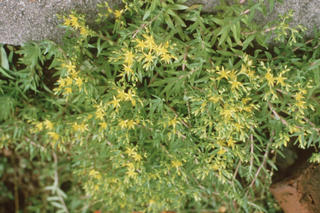Sedum sarmentosum
Contents
Nomenclature
Other Names:
Historical Use of Sedum sarmentosum
Sedum sarmentosum in Traditional Chinese Medicine
Background
Chinese Name (pinyin): Chuipencao
Chinese Name :
Common Name :Stringy stonecrop herp
Specific Name : Herba sedi
Scientific Name:
Collection : The drug is collected in summer and autumn , remove from foreign matter, use freshly or dried.
Description : Stems slender, over 20cm long, some nodes bearing slender adventitious roots. Leaves whorled in 3, oblanceolate to oblong, green, fleshy, 15 - 28mm long, 3 - 7mm wide, nearly acute at the apex, sharply narrow at the base, calcarate, odour slight, taste slightly bitter.
Identification : Eliminate foreign matter, cut into sections for dried herb.
Processing :
Action : To remove damp-heat, and to counteract toxicity.
Indication : jaundice caused by oliguria with damp-heat, acute and chronic hepatitis; carbuncles and sores
Precautions :
Dosage : 250 g of the fresh herb or 15 to 30 g of the dried herb.
Storage : Preserve the dried herb in a dry place.
Synonymns for Sedum sarmentosum
Patent Medicines and Medicines with Multiple Ingredients that include Sedum sarmentosum
Pharmaceutical Information
Chemical Constituents
Evidence or the Use of Sedum sarmentosum in the Treatment of Epilepesy
Basic Science
Animal Studies
Cohort, Case-Control and Non-Randomized Trials
Randomized Controlled Trials
Meta-Analysis
1st Five Results: pubmed search
Meng-Tian Yan, Hong-Zhuan Shi, Qiao-Sheng Guo, Hui-Ying Jiang, Ya-Ting Zhu, Zai-Biao Zhu
[Effect of soil moisture on efficacy to eliminate dampness and relieve jaundice and flavonoid content of Sedum sarmentosum].
Zhongguo Zhong Yao Za Zhi: 2023, 48(21);5750-5758
[PubMed:38114170]
[WorldCat.org]
[DOI]
(P p)
Journal Of Healthcare Engineering
##Title##
J Healthc Eng: 2023, 2023;9857208
[PubMed:37946908]
[WorldCat.org]
[DOI]
(I e)
Zijie Deng, Kerui Huang, Peng Xie, Suisui Xie, Ningyun Zhang, Hanbin Yin, Mo Ping, Yun Wang
##Title##
Mitochondrial DNA B Resour: 2023, 8(5);598-602
[PubMed:37250209]
[WorldCat.org]
[DOI]
(I e)
Li Hao, Ming-Wei Liu, Song-Tao Gu, Xue Huang, Hong Deng, Xu Wang
Retraction Note: Sedum sarmentosum Bunge extract ameliorates lipopolysaccharide- and D-galactosamine-induced acute liver injury by attenuating the hedgehog signaling pathway via regulation of miR-124 expression.
BMC Complement Med Ther: 2022, 22(1);305
[PubMed:36419035]
[WorldCat.org]
[DOI]
(I e)
Zhenxiu Liu, Die Liu, Mingyun Chen, Wei Zong, Xiaoran Zhou, Fancheng Meng, Yunbin Jiang, Min Chen, Zhihua Liao, Guowei Wang
Effects of Sedi Herba (Sedum sarmentosum) on attenuating cholestasis by the activation of the farnesoid x receptor (FXR)-mediated signaling.
Biomed Pharmacother: 2022, 155;113803
[PubMed:36271579]
[WorldCat.org]
[DOI]
(I p)
